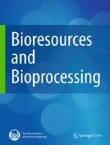Bioresources and Bioprocessing is associated with the State Key Laboratory of Bioreactor Engineering, East China University of Science and Technology.
Penicillin acylase-catalyzed synthesis of N-bromoacetyl-7-aminocephalosporanic acid, the key intermediate for the production of cefathiamidine
Enzymatic approaches have become promising alternatives to chemical methods for the production of semi-synthetic β-lactam antibiotics. In this work, enzymatic synthesis of N-bromoacetyl-7-aminocephalosporanic aci...













